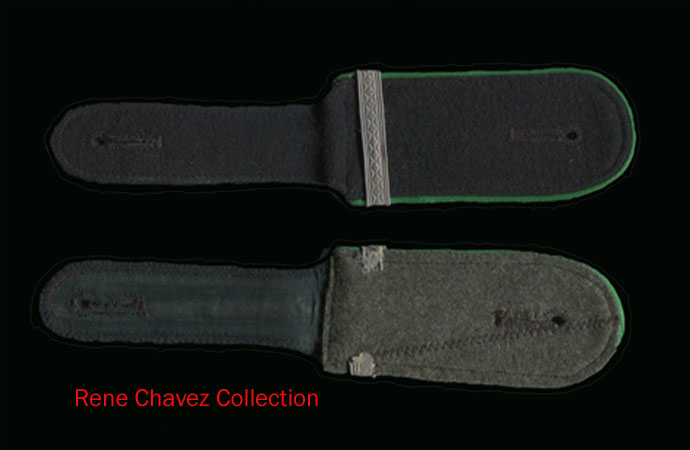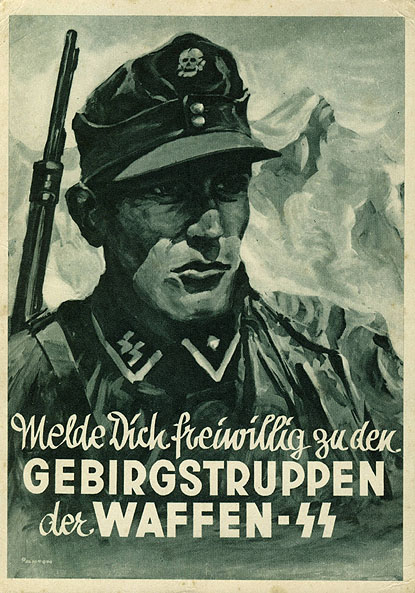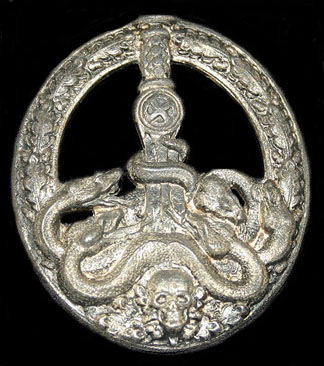7.SS-Freiwilligen-Gebirgs-Division "Prinz Eugen"
|
SS-Freiwilligen-Gerbirgs-Division
On August 7, 1940, Gottlob Berger, head of the SS Main Office (SS-FHA, SS-Furuhngshauptamt) who was in charge of Waffen SS recruiting, sent Reichsführer SS Heinrich Himmler a memorandum outlining his plans for the recruitment of ethnic Germans (Volksdeutsche) from the Balkans into the Waffen SS. Following the invasion and occupation of Yugoslavia, the approximately 700,000 ethnic Germans, Volksdeutsche, living in Yugoslavia, were recruited by the Waffen SS.
The SS-FHA approved the formation of the Volunteer Mountain Division (Freiwilligen Gebirgs Division)on March 1942, which consisted of "Volksdeutsche" (ethnic Germans) from Croatia, Serbia (Banat), Hungary and Romania (Siebenbürg). Forming this specialize Waffen-SS mountain trained unit during the early months of it's history was found
hard in filling its ranks through the use of volunteers so it soon conscription was used to finish the formation of the division,
eventually gaining some 21,500 members. The unit itself was formed from a SS Selbstschutz (SS Protection Force) and
elements of the "Einsatz-Staffel (ES)" (Also called Prinz Eugen) from Croatia.
Because of the dificulties in getting German weaponry This unit used captured equipment such as Czech machine guns and French light tanks.
Once the formation was complete it was assigned to the Balkans as an anti-partisan mountain division the fist such division in Yugoslavia since 1941.
|

In April 1942 the newly form division was accorded the honor title "Prinz Eugen."
All divisional personnel were authorized to wear scripted cuff title shown above bearing the name Prinz Eugen.
The majority of officers and NCOs were composed of German cadre personnel and most were entitled to wear the SS runes, however, the enlisted personnel
forbade the wear of the SS runes on the collar insignia by orders of Reichsführer Himmler as he did not considered it to be a true SS-Division.
Enlisted men were authorized to wear the ancient Odal rune symbolizing kinship on their collars. Illustrated on your left is an example of the Odal rune
collar tab. In addition, all Waffen-SS personnel serving with mountain units were entitled to wear the Edelweiss SS issued black oval shape patch on their
upper right sleeve of the greatcoat and tunic.
Higher rank German officers preferred to wear the Odal rune as a respect to their men however they did wear
a special breast SS runes tab below the breast pocket of their uniform to indicate full SS service. Shown above are three types of breast ss runes, the rarest being the black and white runes worn on white summer tunics. The green and black background breast SS runes were worn by Prinz Eugen personal.
Also illustrated is a rare SS register feldpost with Kenn number 969, FpA 7 SS Division Prinz Eugen mailed March 16, 1944 to Austria from FPN 43476 SS Gebirgsjäger Regiment 13 "Artur Phleps."
Next is a Croatian document with original signature of Artur Phleps.
|

Shown is a midwar pair of SS shoulder boards with the green pipe branch color worn by polizei and members of mountain unit formations such as the Prinz Eugen Division. The boards have a green color piping made of woven artificial silk rayon material.
|
|
Brief
History
It is interesting to know that the title Prinz Eugen comes from the German spelling of the name Francois Eugene,
Prince of Savoy, who lived from 1663 to 1736. Born in Paris, France, Eugene is known to history as being one of the greatest European soldiers of all time.
After being refused a commission in the French army by King Louis XIV, Eugene entered the service of the Holy Roman Emperor Leopold I in 1683,
to fight against the Ottoman Turks.
Made field marshal in 1693 Prince Eugene was the commander and diplomat who led the military campaigns that
would lay the foundations for Habsburg power in central Europe. He fought the Turks at Vienna, and helped to establish the Austro-Hungarian Empire.
He also fought against France in two wars, and while in command of the imperial army he helped Marlborough in several battles during the War of the Spanish
succession. Later, Prince Eugene won several further victories against the Turks, capturing Belgrade in 1718.

As indicated the "SS-Freiwilligen-Gerbirgs-Division" was created for anti-partisan warfare in the Balkan region.
The leadership of the division was entrusted to SS Brigadeführer and Generalmajor of the Waffen SS, Artur Phleps, who on April 20, l942, was promoted to SS Gruppenführer and Generalleutnant of the Waffen SS. Phleps, who had been a soldier in the Austrian Imperial Army, was a Volksdeutsche himself from Transylvania and commanded a Mountain Corps in the Romanian Army until l941.
Not completely formed in October, 1942, elements of the division first saw action near the Serbian-Montenegro border in mountains east of the Ibar River. By December 31, 1942, the division would be made up of 21,102 men: 393 officers, 2,010 NCOs, 18,699 troops. Most of the Officers and NCO's were almost entirely composed of German nationals (Reichsdeutsche).
Soon afterwards it was transferred to the Zagreb-Karlovac area where on the 8 January 1943 it took part in Operation "Weiß" (White) in conjunction with the
Italian 6th Army moving in from the southeast from Mostar and two German units attacking from the north.
This operation lasted from 20 January to the 15 February 1943. Operation White was one of the many major anti-partisan operations in the Balkan Region aimed
at destroying Marshal Tito's resistance movement but by mid-March it proved to be a failure and the operation didn't achieve its goals and most of the Partisans
managed to evade the main attack
Throughout the next few months, the division was placed under Army Group E, and in May, 1943, the division took part in more anti-partisan operations,
this time during Operation "Schwarz" (Black), which began from 15 May and ended 15 June. With the support of the 1st German Mountain Division, elements
of the Brandenburg Regiment, 369th Croatian Infantry Division, 18th and 104th "Jager" Division this operation was successful and the Partisan forces under
General Draza Mihailovic ended up retreating. During this operation the Prinz Eugen Division began gaining a reputation of committing atrocities against civilians.
In August 1943 the division was then attached to the German "XV Gerbirgs Armeekorps" and was sent to the Dalmatian coast to disarm the Italian forces and help
occupied the Hvar, Brac and Korcula islands and the Pelješac Peninsula.

SS-Feldpost cover FPN 44609 mailed by an Italian volunteer who
was assigned to the 2nd Mountain Regiment of the 7th SS Division
Prinz Eugen. The cover has been censored and was canceled in
November 1943.

The
reverse shows the sender's name and FPN 44609.
|
|
7.
SS-Freiwilligen-Gebirgs-Division Prinz Eugen
On 22 October 1943 the Division was reorganized and was renamed to
"7. SS-Freiwilligen-Gebirgs-Division Prinz Eugen."In November the division was placed under the command of the German "V SS Freiwilligen-Gerbirgs Korps" and participated in anti-partisan sweeps in Kugelblitz and Schneesturm.
On 30 January, 1944, the 7th SS Division was placed under the command of Brigadeführer Otto Kumm and was transferred to the Split, Dubrovnik area for refitting.
By March 1944 the division was transferred back to Bosnia for anti-partisan operations. On March 27, l944, Prinz Eugen launched a purge action from Sinj. The following day members of the division overran the villages of Otok, Conji, Ruda, Dolac Dolnji, where all 834 inhabitants were massacred and their bodies burned. Over 500 houses were set on fire and looted.
In May 1944, the division along with the "SS Fallschirmjager Battalion 500"and elements of the 1st "Branderburg" Regiment including major support from the "Luftwaffe" participated in operation "Rösselsprung" against Tito's partisans near Drvar Island.
After Drvar the Prinz Eugen Division saw action in operations Waldrausch, Freie Jagd (June and July) and Rübezahl (12 Aug - 30 Aug 1944), which prevented
the partisans from moving into Montenegro. During that time the Red Army advanced to the Balkans and the division began fighting Russian and Bulgarian units
suffering heavy casualties in the process.

All members of the Prinz Eugen Division were eligible to receive
the "Bandenkampfabzeichen" Anti-Partisan badge.
On 21 September
SS-Obergruppenführer Artur Phleps, the division first commander was believed to have been killed when en-route from Montenegro to Transylvania. He was planning to regroup the frontline against the Soviet Armies. On the 13th of November the 13th Regiment of the Division received the honor title "Artur Phleps."
By late September the division was reorganized with the addition of the "13 Waffen-Gerbirgs-Division des SS Handshar," remnants of the
"23 Waffen-Gerbirgs-Division der SS Kama"(made up of Bosnian Muslims)
and the "21 SS Waffen-Gerbirgs der SS Skandenberg"(This formation was refitted in Kosovo-Metohija and was made up mostly of Kosovo Albanian Muslims). It should be noted that "Kama" and "Skandenburg" were never formed at anything near divisional level.
The division then saw action in what was probably its most important role so far to hold a vital bridgehead in the Vardar Corridor in Macedonia to help evacuate 350,000 German soldiers from possible encirclement by the advancing Soviets. While fighting in the bridgehead the division subordinated to the "Armeekorps under Generaloberst Alexander Löhrs Heersgruppe E." The 350,000 German soldiers were attempting to move north from occupation duties in the Aegean and Greek regions of the Balkans. The Prinz Eugen Division
was badly mauled, however, the operation proved to be a success.
On 20 October 1944, the Soviets captured Belgrade and Prinz Eugen retreated through various areas such as Cacak, Uzice, Bajina Basta, Ljubovija, Zvornik, Bijeljina, to Brcko and over Drina, while still rear guarding the German retreat. Due to heavy casualties the divisional SS-Kavallerie-Abteilung 7 was disbanded.
In early November the "SS Skanderberg" Division was disbanded (other sources indicate that the "SS-Skandeberg Div." was dissolved in December 1944). The remnants were incorporated into the 14th
Mountain Regiment of Prinz Eugen, which received its honor title "Skanderbeg." The fighting around Nišch in October caused the unit some heavy casualties and the division was sent for reffiting.
In January, 1945, the division fought the partisans near Otok, and later was sent to the area of Vukovar where it fought retreating battles against the advancing Soviet and Bulgarian forces as well as Tito's partisans.
From February, 1945 to April, 1945, the Division was in constant retreat fighting against the Partisans and the Soviets holding positions near Karlovac on 2 May 1945. The remnants of the Prinz Eugen Division ended the War in Celje, Slovenia where it surrendered on 11 May 1945 to Yugoslav forces.
[ Front
Page] [Top ][Previous
Page] [Next Page]
|
|





